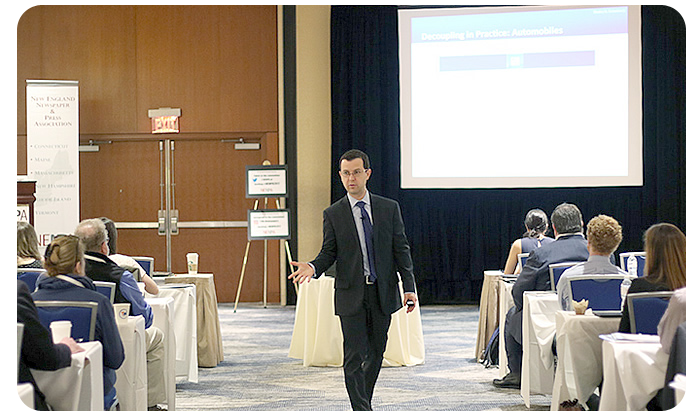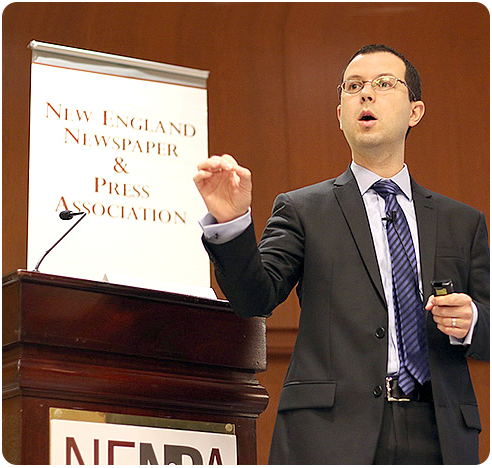By Aneri Pattani,
Bulletin Correspondent

‘Local newspapers have as their best monopoly community news.’
—Thales Teixeira, Marketing professor, Harvard Business School
The disruption of the newspaper industry began with the advent of the internet as a consumer technology in the 1990s. In the decades since, online news aggregators, digital advertising and social media giants have chipped away at the business model of news. But that process is not inevitable nor irreversible, according to Thales Teixeira, a professor in the marketing unit at Harvard Business School.
There is a recipe for disrupting markets, and newspapers can put that to use for themselves too, Teixeira explained in his keynote speech Friday, Feb. 24, at the New England Newspaper and Press Association’s winter convention in the Boston Long Wharf Marriott hotel.
In his speech, entitled “Responding to digital disruption,” Teixeira revealed the key to disruption, which he learned from studying startups. He calls it “decoupling.”
The traditional consumer process is like a linked chain. Consumers evaluate the different options available for some product, pick one, purchase it and use it. Teixeira likes to say the events in that chain are coupled, or bound together. Disrupters work by decoupling the chain.
Twenty years ago, a reader would buy The New York Times and receive a bundle of products — news stories, classified advertisements, restaurant reviews and more. Today, those services have been decoupled by various disrupters. Google has become a source for news stories. Craigslist provides easy access to classified ads. Yelp handles restaurant reviews.
A similar process occurred in broadcast news. Traditionally, viewers watched news shows and sat through the commercials that generated revenue for those programs. Now, viewers can use TiVo or DVR to bypass the ads, or they can turn to Netflix to stream video. The old business model for broadcast television has been decoupled.
Teixeira said disrupters are successful because they find the weak link in the coupled consumer chain and decouple it. Those companies find ways to create new value, such as WhatsApp, which provides free text messaging across borders, or to reduce hassle, such as Fresh Direct, which delivers groceries to a customer’s door.
Consumers prefer anything that can reduce monetary, time or effort costs, Teixeira said.
Incumbents in any industry can recognize that and try to prevent disruption in two ways: recoupling or rebalancing. Recoupling, which refers to maintaining the traditional consumer chain, often involves forcing contracts on customers to keep them committed to a service or lobbying the government to outlaw a separation of activities.
Teixeira recommends rebalancing instead.
Rather than waiting for the purchasing stage at the end of the consumer chain, rebalancing involves companies monetizing as many stages in the chain as they can.
Teixeira used an analogy to explain: “If you are at the beginning of a pipeline and don’t capture value until the end, then a disrupter can drill a hole in the middle and get all the oil.”
He pointed to Best Buy as an example of rebalancing at its best. Realizing that many customers were testing out products in store but then buying them online from Amazon, the company decided to find another revenue stream. It recognized that it was creating value for suppliers such as Samsung by showcasing their products in-store, so Best Buy turned to those suppliers and began charging them a display fee.
The New York Times is doing that in some ways, Teixeira said. When the newspaper realized it was creating more value for online readers than it was for online advertisers, it switched from an advertisement-based revenue model to a subscription-based one. It put up a paywall to charge readers for the value of its content. It is also trying to create additional value through new apps, blogs, crossword puzzles and more.
Local newspapers, which have been hit by disruption in the industry, can also learn from disrupters.
“Local newspapers have as their best monopoly community news,” Teixeira said.
They need to harness that monopoly to create value. Local newspapers can facilitate conversation between people and local officials about what the town wants and needs, Teixeira said.
“People will pay to have that conversation,” he said.
The key to a successful business model is recognizing the value you bring to a customer, Teixeira said.
“If you disappear from the map tomorrow, who would most miss you? Use the answer to figure out who will pay for your services,” he said.



